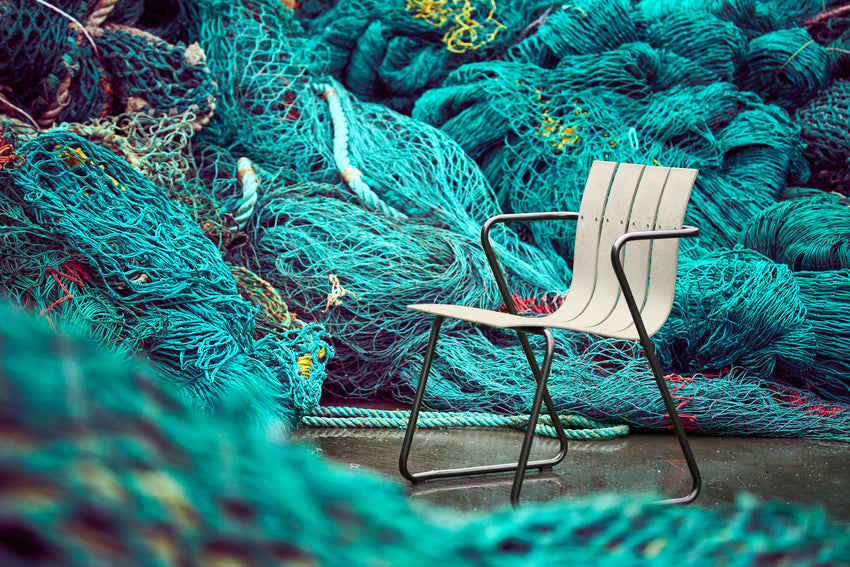
A Sustainable, Nontoxic Furniture Primer
Furniture is everywhere in our daily lives. We live with it and on it all day and night, but what effect do these everyday objects have on our health and on the planet?
I dug into this question while working with several top furniture brands. They were surprisingly unaware of the full supply chain, material, and production impacts of the furniture industry. While trying to influence these industry leaders toward cleaner, greener, socially responsible production, I learned...
A) It isn’t as simple or cheap to make sustainable, non-toxic furniture (not surprising).
B) There are some furniture companies that have found wonderful ways to do it.
C) It's not super easy to find truly sustainable, well designed furniture.
Before we jump in, choosing used furniture is one sustainable approach since you're keeping products in circulation and out of the landfill. The downside is, most will be made with some toxic and unsustainable materials. More on that later.
This primer demystifies the process of finding furnishings that are eco-friendly, ethical, and non-toxic.
It’s especially important the furniture in our lives isn't made of unhealthy materials since we spend more time with it than with any other consumer product—with the possible exception of personal tech devices.
There is a lot of research out there to slog through, but the good news is, I did it for you. The essentials are captured in a few key principles about materials, production methods, and life cycle impacts. These will lead you to low impact sofas, tables, cabinets and chairs you'll love bringing into your home.
What Makes Furniture Sustainable? The Essentials...
Materials: Low environmental impact in terms of sourcing. The raw materials are renewable, recyclable, upcyclable, and non-toxic. Their processing creates minimal or no toxic pollution.
Production methods: Small carbon footprint, positive or neutral social impact (fair trade, fair made).
Finishes: Non-toxic ingredients, minimal or no off-gassing of harmful fumes (volatile organic compounds). Usually safer finishes are water based.
Life cycle: Product creates a low impact from cradle to grave, end of life. It is reusable, recyclable, or biodegradable. Better yet, it may be a cradle-to-cradle product that can be reused or repurposed at the end of its first life (a circular design).
Durability: The design is enduring. The aesthetic, materials and construction are durable.
Third-Party Certified: Reputable, independent certifying organizations verify environmental claims, health, and social impacts of products. Look for certifications like Forest Stewardship Council, Oeko-Tex, and Greenguard Gold.
With all these factors to take into account, you can see why it's difficult to find truly sustainable and nontoxic furniture, let alone stylish. These essentials are what we use to create our criteria for evaluating products. We're proud to say everything in our collection meets these high standards. Learn more about our standards here.
I'm thrilled to introduce our launch collection brand partners, who share these standards. Each one is committed to transforming furniture to be better for people and the planet.
Biosofa - Owner Davide Barzaghi inherited his family's furniture factories. He embarked on a mission to transform the business, and only make beautiful sofas free of standard petroleum-based foam and harmful chemicals common in upholstered furniture. All Biosofa's materials are also plastic-free and biodegradable.
Emeco - A globally recognized pioneer in sustainable furniture, Emeco is proudly based in the small town of Hanover, PA. Innovators in diverting waste streams and transforming them into timeless furniture, Emeco works with reclaimed and recycled cork, plastic bottles, and endlessly recyclable aluminum.
FiVO - FiVO furniture is modular and made to transform with the owner's needs. Every product is made with their ingenious Infiniti Joinery System, interconnecting wood panels without hardware or tools. They only work with FSC Certified wood.
Formr - The motto at Formr is Second chances for people and planet. Each year more than 500 million tons of construction waste is generated, most of it ending up in overflowing landfills. Formr repurposes carefully selected wood from construction waste into original furniture designs that are built to last. And they employ the formerly incarcerated, giving them a second chance too.
Greenington - Innovative manufacturing methods and fine design has made Greenington the leading maker of modern bamboo furniture. Bamboo is an amazingly versatile, fast-growing grass. It is also a carbon sequestering power house, requiring no chemical inputs to grow. Greenington furniture is made only of sustainably harvested, solid moso bamboo.
Mater - Mater combines sustainability and circular production using waste from plastic and fiber-based materials, with timeless design. Collaborations are realized with both well-established and new design design talents to create their award-winning collections. Their Ocean Collection is a great example, made of discarded plastic fishing nets (see image above).
Normann Copenhagen - Normann Copenhagen marries the craftsmanship, functionality and durability of their Danish design heritage with modern silhouettes and durable materials. They are expanding their sustainable product offerings beyond their iconic recycled plastic stool, with hemp-based chairs and FSC Certification for wood furniture.
L. Christina Cobb, Founder + CEO


